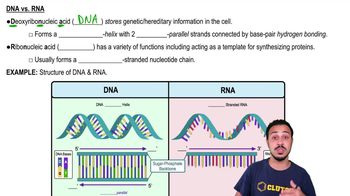Textbook Question
The information sequence that determines the nature of a protein is:
a. Nucleotide
b. Gene
c. Triplet
d. Codon
32
views
 Verified step by step guidance
Verified step by step guidance Verified video answer for a similar problem:
Verified video answer for a similar problem:



 5:03m
5:03mMaster 1) Initiation of Translation with a bite sized video explanation from Bruce Bryan
Start learning